Icteridae is the family of New World Blackbirds and contains a total of 29 different genera.
This is one of the most fascinating families of birds. Members of this family are found all over North, South, and Central America.
From the widespread Red-winged Blackbird to the very vocal Western Meadowlark, these birds are some of the most recognizable songbirds in the USA.
I will go over 5 of the most common genera within this family:
- Grackles (Quiscalus)
- Red-winged Blackbirds (Agelaius)
- Brewer’s Blackbirds (Euphagus)
- Cowbirds (Molothrus)
- Meadowlarks (Sturnella)
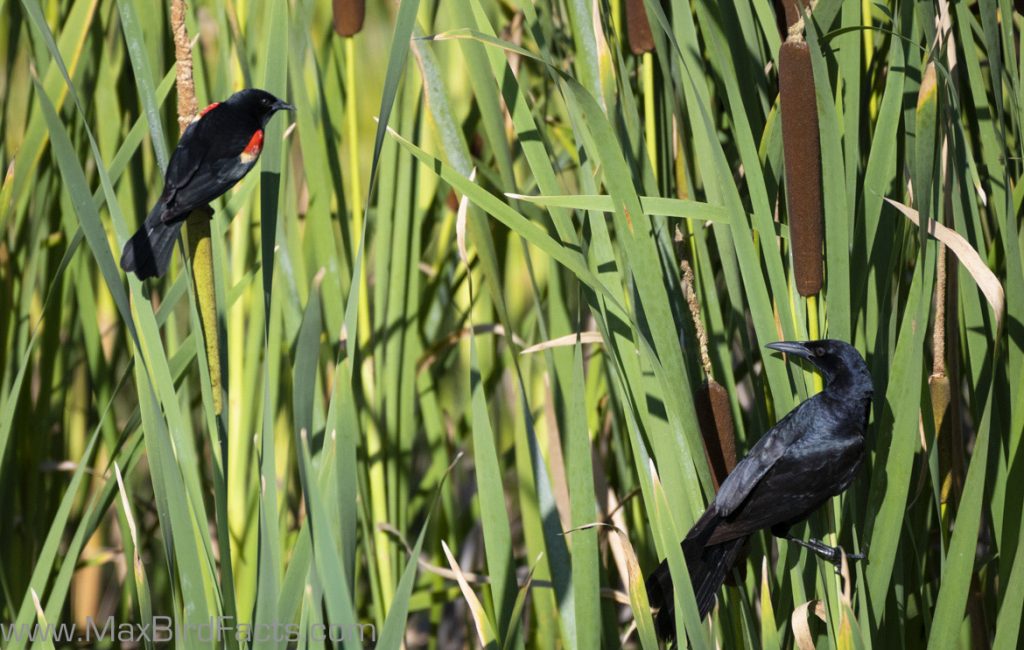
In each section, I will discuss some of the unique features and characteristics of that genus and contrast them to the other genera we will discuss.
1. Grackles (Quiscalus)
Two species of Grackle found throughout Florida are the Boat-tailed and Common Grackles. There are four other species within the genus Quiscalus, but these two represent their cousins well.
Grackles can be quickly distinguished from other Icterids by their lanky appearance and willingness to stalk and forage on the ground. These birds will often perch in prominent areas in clear view and make their calls, much like the other members of Icteridae.
Their long legs and upright posture make these birds appear very lean compared to other Icterids. The latter typically keep their necks tucked into their shoulders.
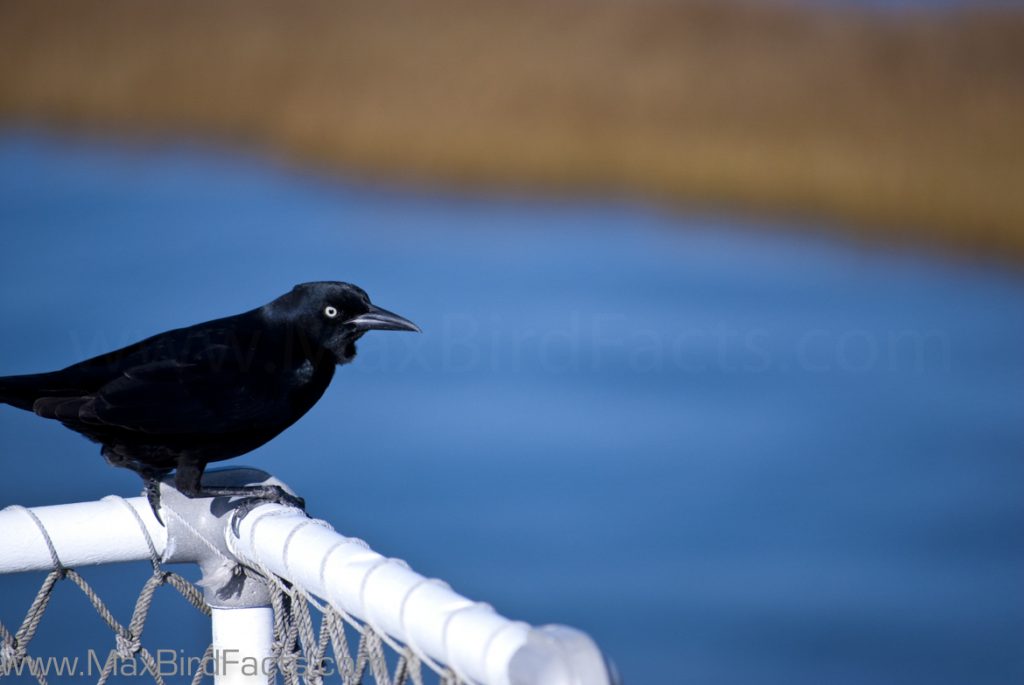
The Grackle’s beak is a speedy way to distinguish it from a Blackbird.
Long, gradually tapered, and having a slight downward curve at the tip, these beaks are perfect generalist tools. The beak is roughly the same size or longer than the head in most Grackle species.
This beak style is perfect for probing the soil for seeds and insects, picking apart fruit or animal flesh, or any other need for the bird.
Grackles are opportunistic hunters and, like most birds, will not pass up a meal when it presents itself.
The Boat-tailed Grackle has a slightly larger body than the Common, but it has a much more substantial tail. The Boat-tailed Grackle’s tail is massive, approximately the same length as the body.
The tail itself is distally (farther from the body) broader. It narrows proximally (closer to the body), creating a keel-shaped appearance.
Compare this to the Common Grackle, whose tail is at most 50% the length of its body. The tail’s shape is more rectangular and straight than the well-defined V-shape seen in the Boat-tailed Grackle.

This fact will become especially important once we discuss some of the other features of these birds.
Once you’ve got a good look at those tail feathers, look at the Grackle’s eyes.
If the bird staring back at you has bright yellow irises, you probably have a Common Grackle. But this isn’t always the case.
Typically, Boat-tailed Grackles will have dark orangish-brown eyes, but this is regional. In Florida, we have Boat-tailed Grackles with brown irises, and this can vary from a sandy color to a dark chocolate brown.
Gulf Coast and Florida Boat-tailed Grackles will also keep the brown eyes. However, on the Atlantic Coast, they share the same bright yellow iris as Common Grackles.
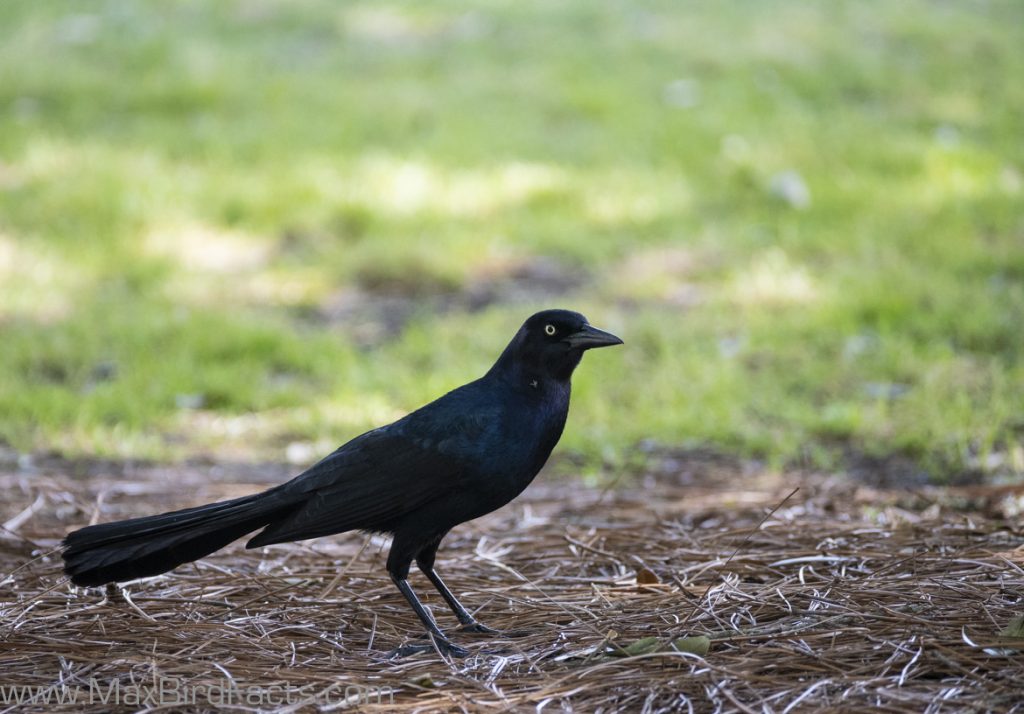
This fact illuded me for a while, making it difficult to know which species I was looking at if I didn’t have a clear sight of the tail.
So when identifying between these two Grackle species, keep in mind the eye color of your region. Suppose you are along the Gulf Coast, and you see a “blackbird” that has a lean, tall body shape, a long, sharp, and slightly curved bill, along with brown eyes and iridescent feathers. In that case, you probably have a Boat-tailed Grackle.
Things get a little more complex along the Atlantic Coast. Because both species, Boat-tailed and Common, share the yellow eye color, the best way to positively identify what species you see is its tail size.
Remember, the Boat-tailed Grackle’s tail is roughly the same length as the rest of its body, whereas a Common Grackle’s tail is at most 50% of its body length.
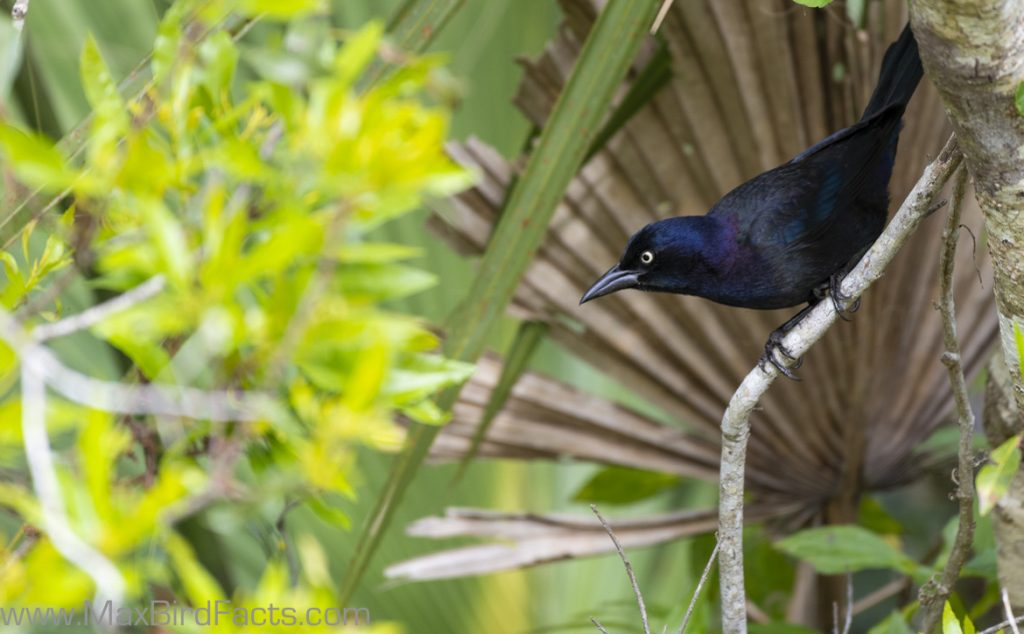
The final trait to keep in mind is the presence of a crest or crown.
Boat-tailed Grackles will have a rounded crown of feathers that extends when making calls and displays. This is lacking in Common Grackles, who have no apparent head ornamentation when vocalizing.
And when trying to determine if you are seeing a female Boat-tailed or Common Grackle, look at the eyes. Just like their male counterparts, Boat-taileds will have brown eyes while Commons will have yellow.
Remember, this isn’t foolproof because of the yellow-eyed Atlantic Coast Boat-tailed Grackles, but it is a good rule of thumb.
You can still go off of the size of the birds if you are along the Atlantic Coast. However, the easier way of determining what species of Grackle you are looking at is by finding a male.
If you see a handful of females perched or hopping along the ground, chances are there is a male not far away. Wait a few moments, and he will show up; then, you can very clearly make the distinction.
2. Red-winged Blackbirds (Agelaius)
The headline species within this genus, the Red-winged Blackbird, perfectly represents its cousins.
This medium-sized songbird has brilliant red and yellow epaulets (shoulder displays).
These birds are notably territorial because they need to secure a region housing the requirements to keep these feathers brilliantly red.
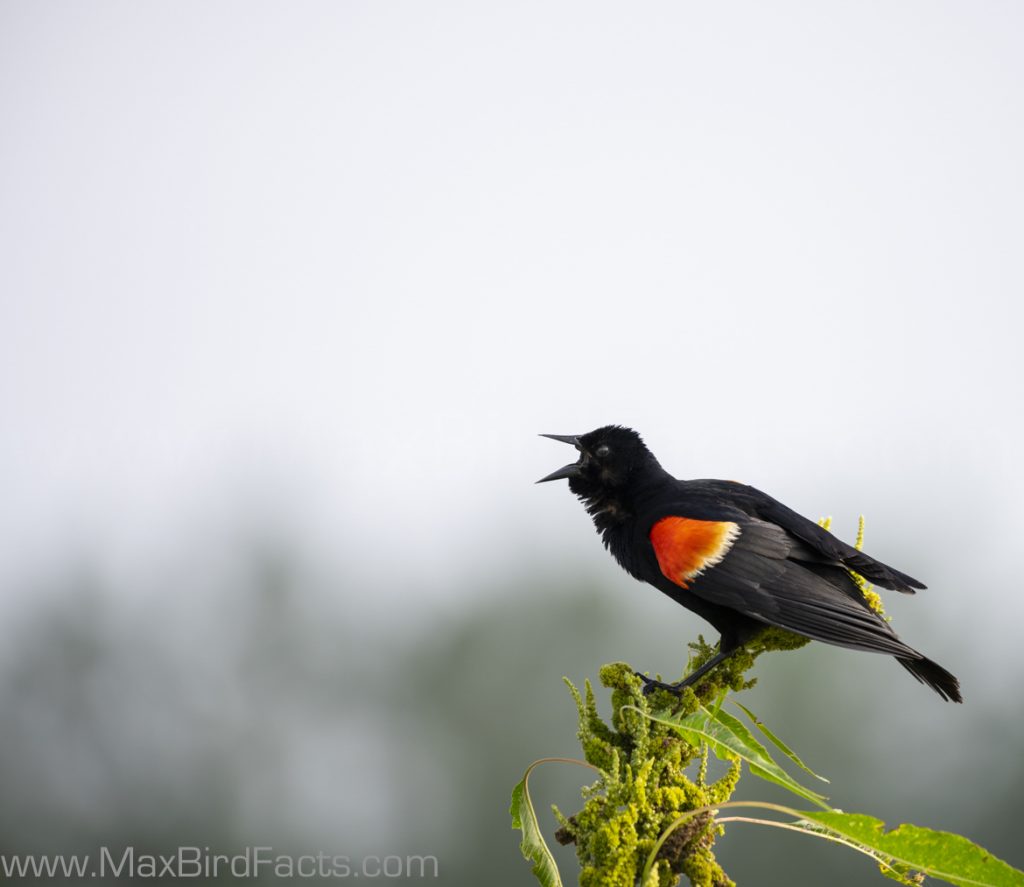
Red, orange, and yellow colors are caused by a chemical family called carotenoids. This compound is found in several plants, fruits, berries, and flowers.
Unlike Grackles, whose iridescence is caused by the structure of the feathers, a Red-winged Blackbird’s red epaulettes are caused by its diet.
A Red-winged Blackbird needs to have a diet rich in carotenoids to maintain the red epaulets they are so well known for. If they cannot find foods rich in this compound, their red color will dull and become less attractive to females.
If you see these red patches on the bird’s shoulders, you are looking at a Red-winged Blackbird. They use these feathers to show off during their calls.
Flexing their wings outward to expand the epaulets shows off the bright colors as a warning to other males and a way to draw females.
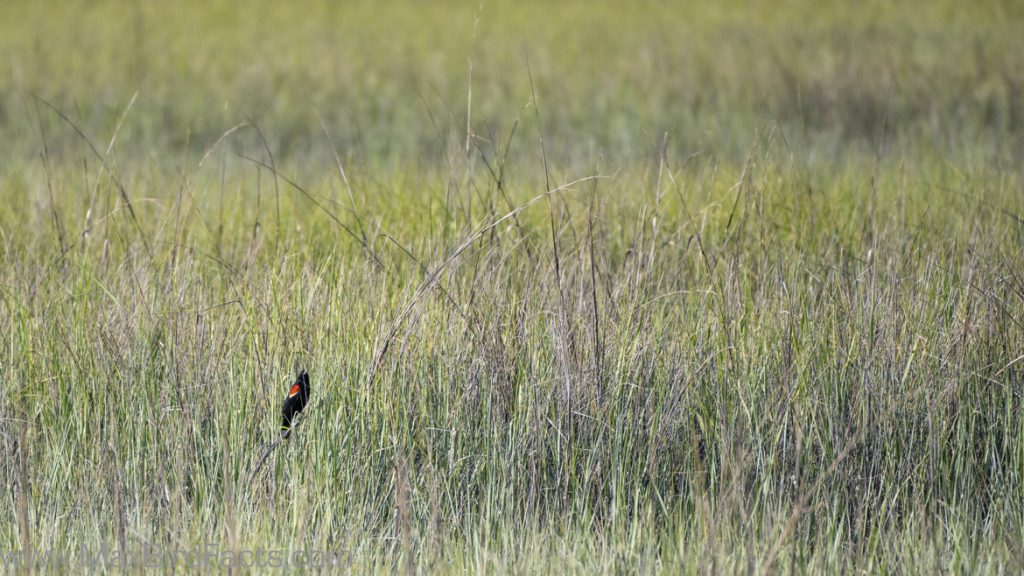
The rest of the body will appear almost jet-black. Unlike our Grackles, you can see virtually no iridescence on the rest of a Red-winged Blackbird’s feathers.
This bird’s body stature is much different than our Grackles. Significantly smaller overall, Red-winged Blackbirds should be very easy to spot from a Grackle.
Their chunkier appearance, round head, short neck and legs, and overall smaller size are immediate indicators.
The next thing to look for is pigmentary coloration (red, orange, and yellow). If your bird has these bold epaulets, you know you are looking at a Red-winged Blackbird.
A Red-winged Blackbird’s beak is also very different from a Grackle’s. It is very triangular, with a broad, thick base that quickly tapers into a very acute point.
This is a very generalistic beak shape and works perfectly with the lifestyle these birds hold. Easily used to crush seeds and grains while also staying precise enough to finely pick or probe at food.
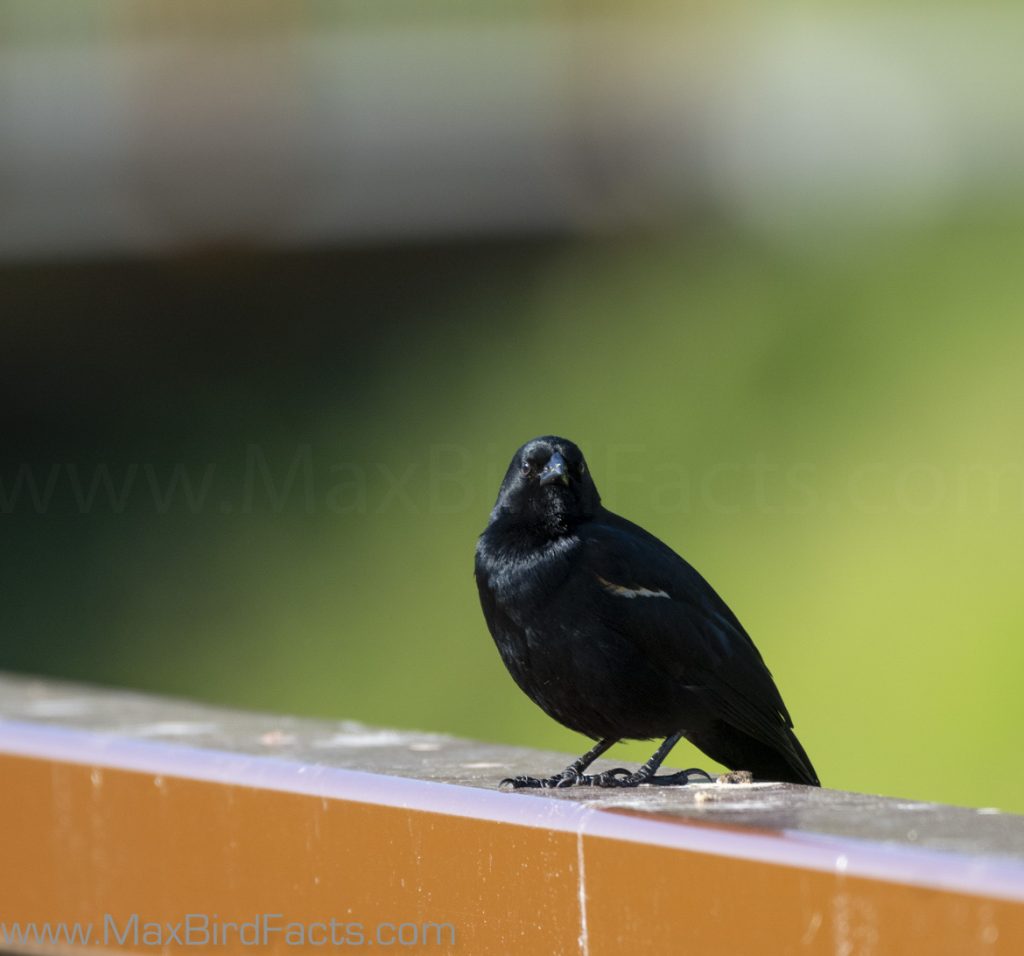
If you want to read more about how to correctly identify a Grackle from a Blackbird, check out my article Grackle vs Blackbird – 3 Easy to Remember Features to Look Out For When Identifying. In that article, I go much more in-depth with the details about Red-winged Blackbirds and their differences from Grackles.
3. Brewer’s Blackbirds (Euphagus)
Only two living species remain within this genus, but I felt like they needed to make an appearance here.
I’ve named this section specifically after the species we are about to talk about, the Brewer’s Blackbird because I only have a single image to show for this genus.
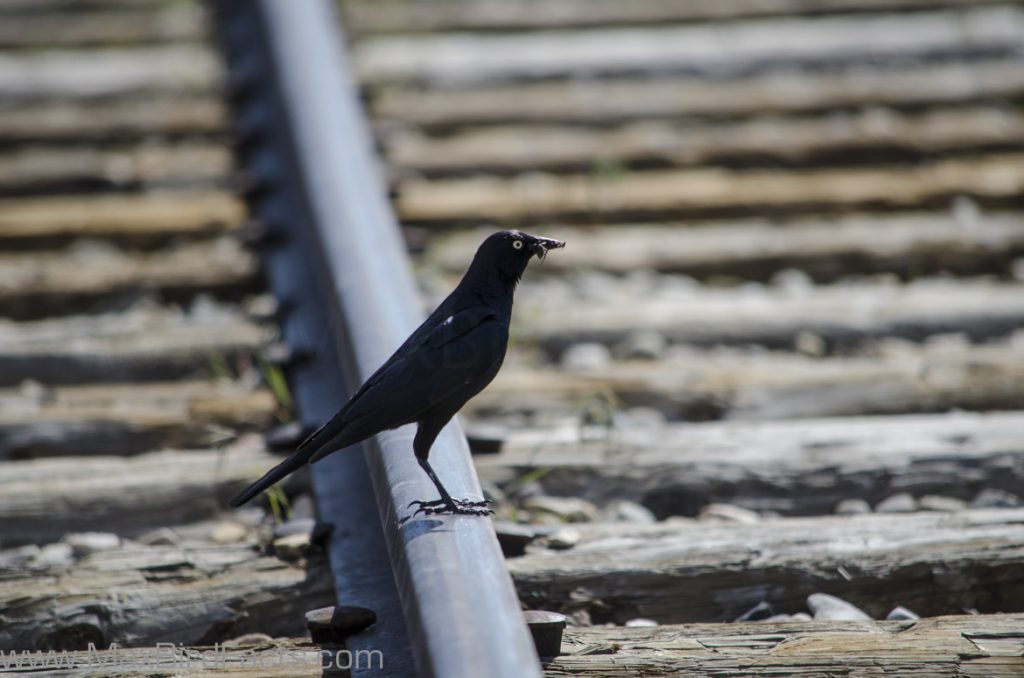
This group of Blackbirds almost seems to be a hybrid between the Grackles and Blackbirds.
Moving from head to toe, the head of this bird is very similar to our other Blackbirds. Overall rounded in appearance and lacking any ornamentation, and is very plain.
The eyes on this bird are particularly unique. A bright yellow iris stands in stark contrast to the otherwise drab bird.
This feature is what caused me to initially think the image I captured was of a Common Grackle.
The body shape of these Icterids also doesn’t help much. They share a more upright posture, like Grackles, with a long tail and large feet for walking on the ground.
However, looking at the beak, it doesn’t take the same sharp downward curve as we saw in the Grackle. Our Brewer’s Blackbird beak is much closer to that of the Red-winged Blackbird.
Starting relatively broad and then rapidly tapering down to that excellent point. Though it isn’t as wide in the base, the beak still lacks that distinct downward curve in the maxillary tip that we saw in both Grackle species.
The feathers are where this bird can really trip you up in the field.
Unlike other North American Blackbirds, the black feathers on Brewer’s Blackbird clearly show iridescence.
This structural coloration, along with the yellow iris, is what threw me off when first identifying this bird.
Without looking at the beak, I wouldn’t blame you for thinking this is a Common Grackle.
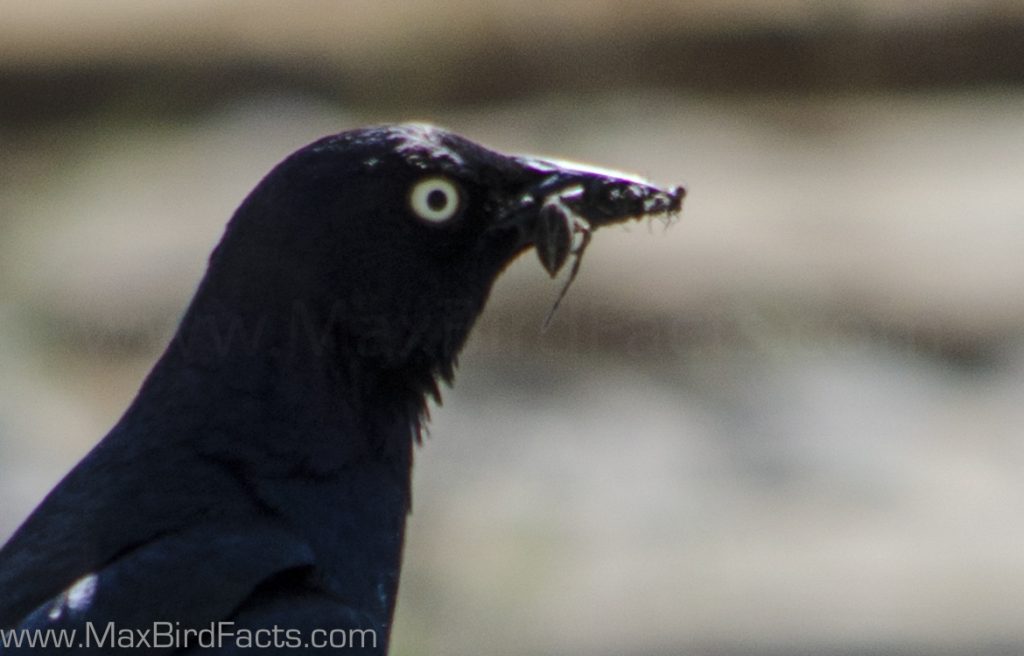
The ranges of these birds also overlap, making it extremely frustrating when trying to make an accurate identification.
The feet are also more like Blackbirds than the Grackles.
Tiny toes and relatively short talons could be caused by the overall small size and its need for perching rather than walking.
The size of this bird is also within the exact dimensions of our Red-winged Blackbirds rather than Grackles.
So, if you are in the western regions of the US, Canada, or Mexico and you see a small, iridescent bird with yellow eyes, look a little closer. It might be a Brewer’s Blackbird instead of a Common Grackle.
Its close relationship to Quiscalus could cause this almost hybrid look to Brewer’s Blackbird.
It seems that, genetically, Euphagus could be the linking relative from Grackles to other Blackbirds.
Still, the most significant distinction between this bird and the Grackles is its body size and beak shape.
This Blackbird is at least two to four inches smaller than a Common Grackle and possesses a noncurved beak, like its cousins, the Red-winged Blackbird.
4. Cowbirds (Molothrus)
A Cowbird could easily be mistaken for a Blackbird at first glance.
They share a short neck, stocky appearance, broad base tapering to a fine beak, and black non-iridescent body feathers.
A Cowbird’s head is also approximately the same shape as a Blackbird’s, rounded with no discernable crest or crown.
The beak is also very similar, with a broad, sturdy base that tapers into a precise point. Their bill is somewhat shorter than the Blackbirds. However, the differences are so minute it isn’t a reliable way to determine the difference in genera.
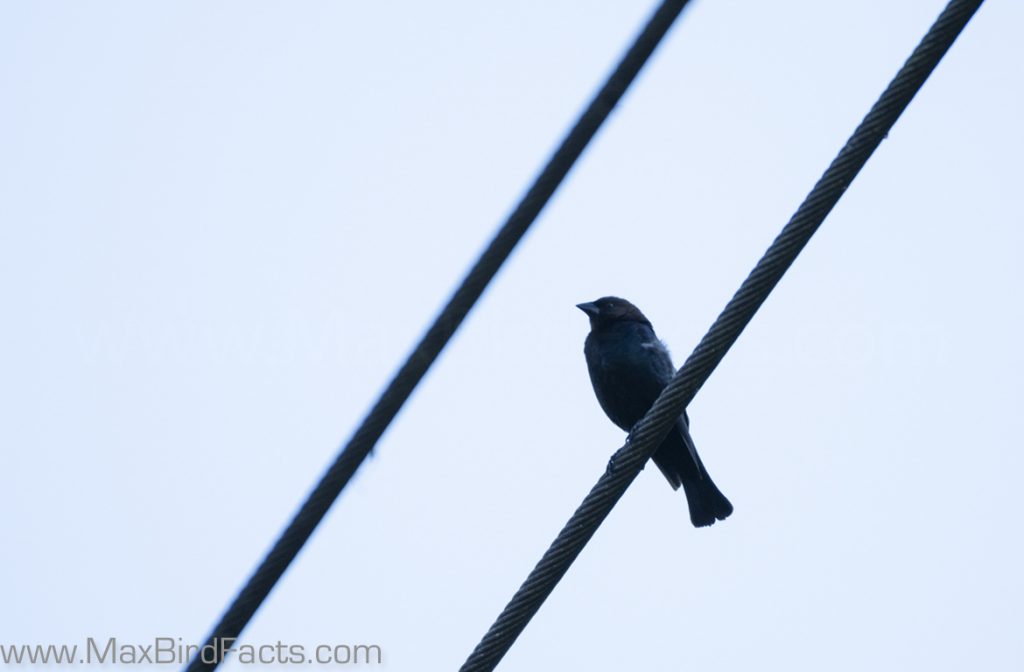
The easiest method to tell if you see a Cowbird is its lack of coloration.
In this way, some species of Cowbird could be considered a true “Blackbird.”
Unlike the Red-wing Blackbird or other members of Agelaius, Cowbirds do not show any red, orange, or yellow patches or markings on their bodies.
Instead, Cowbirds show trivial iridescence in their black feathers. They occasionally have a different aspect to the head feathers, as we can see with our Brown-headed Cowbirds.
Other species within this genus will have bright red or yellow eyes, but they all share the same compact, chunky body size.
Again, the easiest way to know if your bird is a Cowbird is to look for its size and coloration.
Cowbirds are the smallest bird on this list. Being nearly half the size of a Grackle and noticeably smaller than the Red-winged and Brewer’ Blackbirds.
Every species of Cowbird have dark, shiny black bodies, with some species having slightly iridescent feathers.

Still, the size difference is striking enough that you shouldn’t have any problem deciding if you are looking at a Cowbird or a Grackle.
Cowbirds also lack the pigmentary coloration we see in Blackbirds. The red, orange and yellow patches seen on our Red-winged Blackbirds are the most immediate way to differentiate these two genera.
Because the body shape and beak structure are so similar between Blackbirds and Cowbirds, it is best to focus on finding these patches of color.
5. Meadowlarks (Sturnella)
I saved the Meadowlarks for last because they are by far the easiest genus to distinguish from the other four in this list.
I won’t go into massive detail about the Eastern and Western Meadowlarks here in this article. That is another one I am currently researching.
The most striking difference we see on Meadowlarks is their gorgeous yellow breasts cut by a striking black chevron.

When making its call, the bird extends its head and neck upward, exposing this flash of gold. This coloration is from the same chemical compounds our Red-winged Blackbirds use, carotenoids.
These colors are relatively common among birds and allow them to have dazzling visual displays.
When the Meadowlark exposes its throat and breast while singing, it also shows how successful it is at finding food and defending territory. This is just like how Red-winged Blackbirds extend their wings to flash their epaulets to show off their fitness.
Their back feathers are sandy brown, with vertical black striping. This pattern makes them all but disappear in the grass as they forage.
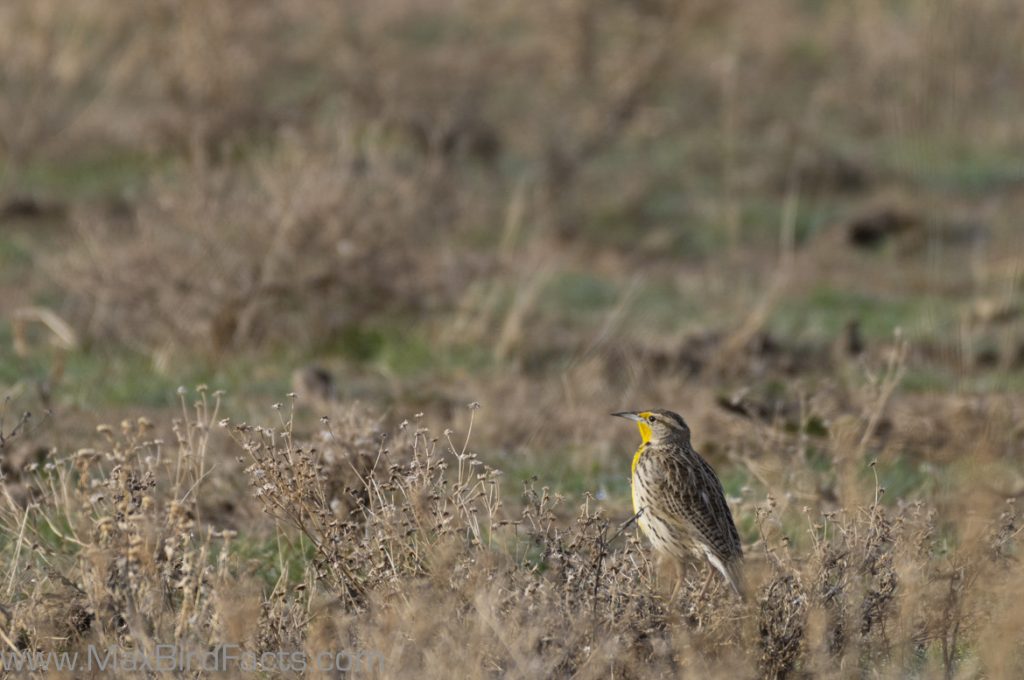
When perched, the posture of the Meadowlark is very similar to a Blackbird. Keeping its head and neck tucked away and appearing fairly stout for the size it is.
The beak is remarkably long and spear-like, somewhat of a hybrid between a Grackle’s gentle taper and Blackbird’s exact point.
Again, it is a rather unlikely bird to accidentally ID like any other bird in this list due to its iconic yellow and black coloration.
Essential Things to Keep in Mind
Remember the main aspects of each of these groups of birds, and you will easily be able to know which one you are looking at. Below is a summary of what to keep a lookout for.
The fastest way to know what bird you are looking at will be by observing its size and body shape:
- Grackles are by far the biggest bird on the list, with a tall, lanky appearance.
- Meadowlarks follow in a trailing second place, having a more squat posture but still somewhat leaner than other birds on this list.
- Red-winged Blackbirds and Brewer’s Blackbirds are about the same overall size. However, their body shape is very different. The Red-winged’s posture is short, stocky, barrel-chested, and chubby, while the Brewer’s is more upright and similar to a Grackle. Their heads are rounded with no ornamentation, and beak shapes are triangular and evenly tapered from the base to the tip.
- Cowbirds appear like a smaller version of the Red-winged Blackbird. A very stocky profile, round head, short beak, and chunky body.
Keep an eye out for coloration as well:
- Grackles and Brewer’s Blackbirds have iridescent feathers.
- Red-winged Blackbirds have red, orange, or yellow epaulets on their shoulders.
- Cowbirds have some iridescence but are essentially shiny black, with some species having different colored heads or eyes.
- Meadowlarks have bright yellow throats and breasts, split with a broad black chevron.
Finally, look at their beak and tail shape and size:
- Grackles have a very long, cone-shaped beak, the maxillary tip has a slight downward curve, and it is roughly the same length as the head. Depending on the species of Grackle, the tail can be between 50-100% of the overall body length. It will be more rectangular and elongated than the Blackbirds.
- Meadowlarks have an extremely sharp, spear-shaped beak. This is perfect for probing into the soil, looking for insects and seeds. Their tail is much shorter than the Grackle’s but is also rectangular.
- Red-winged Blackbirds, Brewer’s Blackbirds, and Cowbirds all share a nearly identically shaped beak. There are very slight differences in the tapering from base to tip, but overall the beak is triangular-shaped. Their tails are also highly similar, being the classic fan-shaped tail we see in nearly all songbirds.
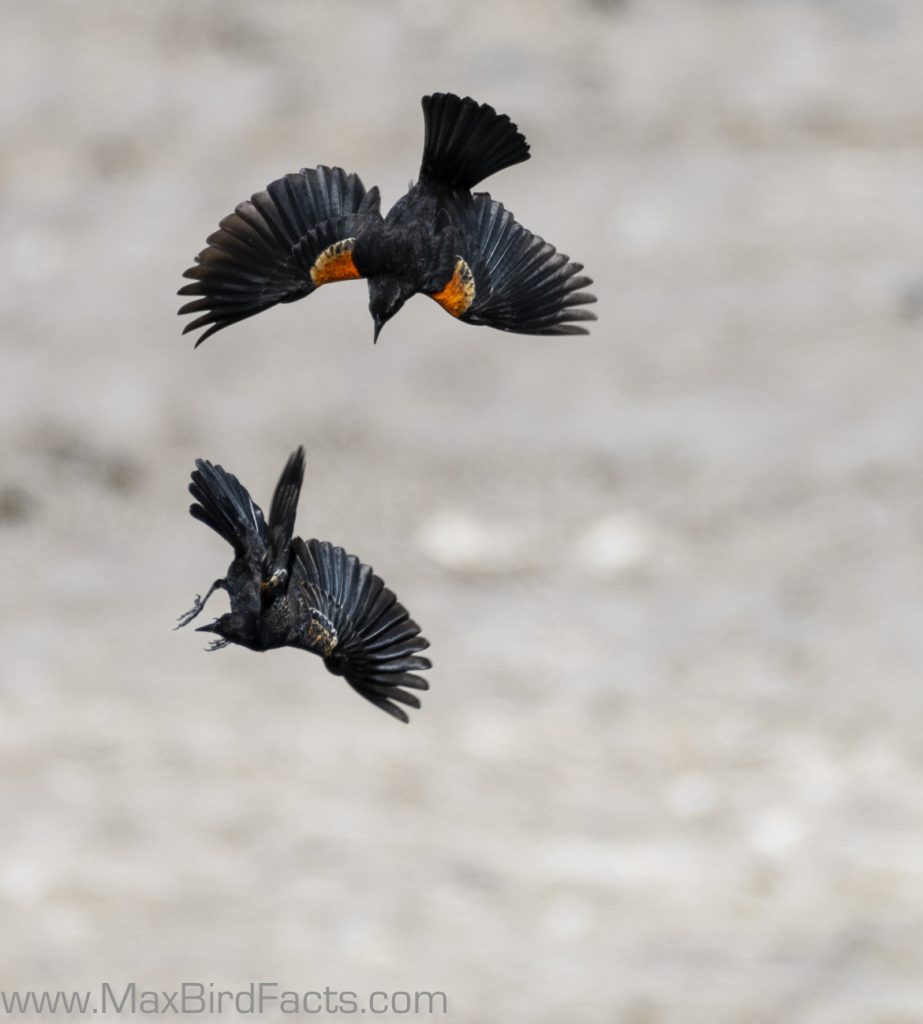
I hope you can appreciate these fantastic birds a little more now after reading this.
If you would like to see a more detailed breakdown between Grackles and Blackbirds, check out my article Grackle vs Blackbird – 3 Easy to Remember Features to Look Out For When Identifying.
Let me know what other bird facts you want to read about in the comments!
Get Outside & Happy Birding!!!
Max
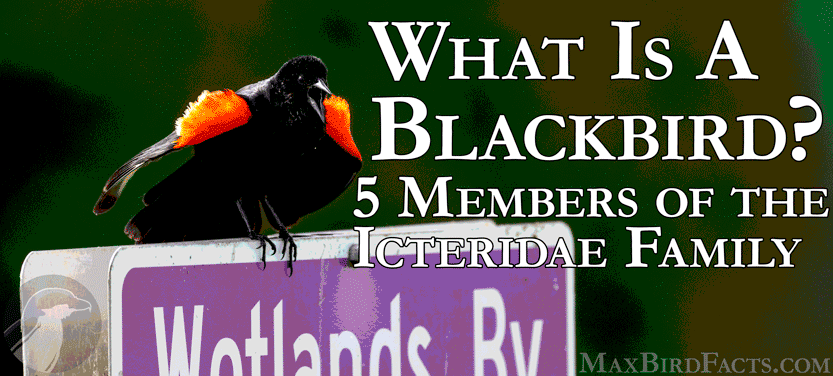
Thanks for your blog, nice to read. Do not stop.
Thank you, Mark!
Pingback: Grackle vs Blackbird – 3 Easy to Remember Features to Look Out For When Identifying – Welcome to MaxBirdFacts.com!!!